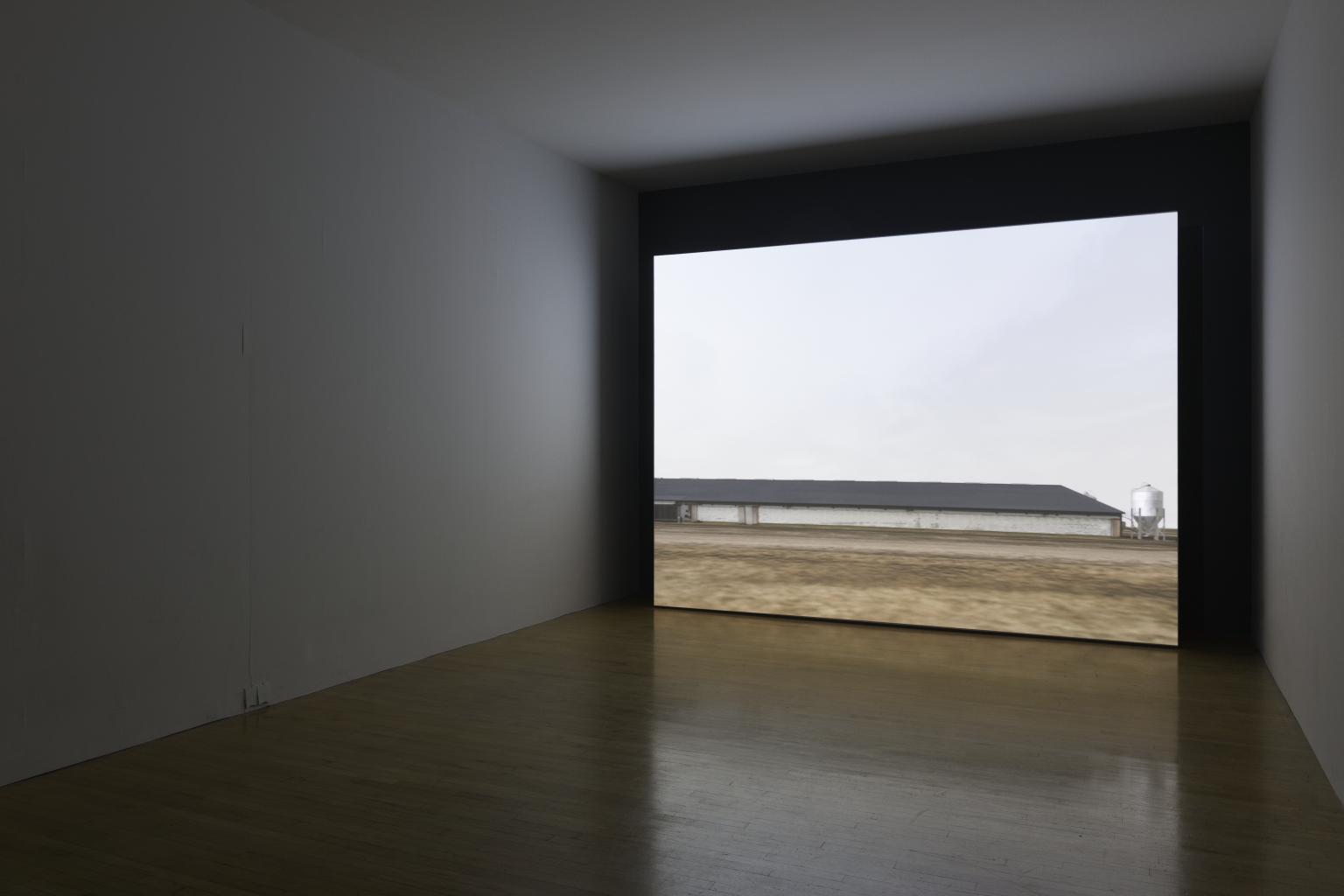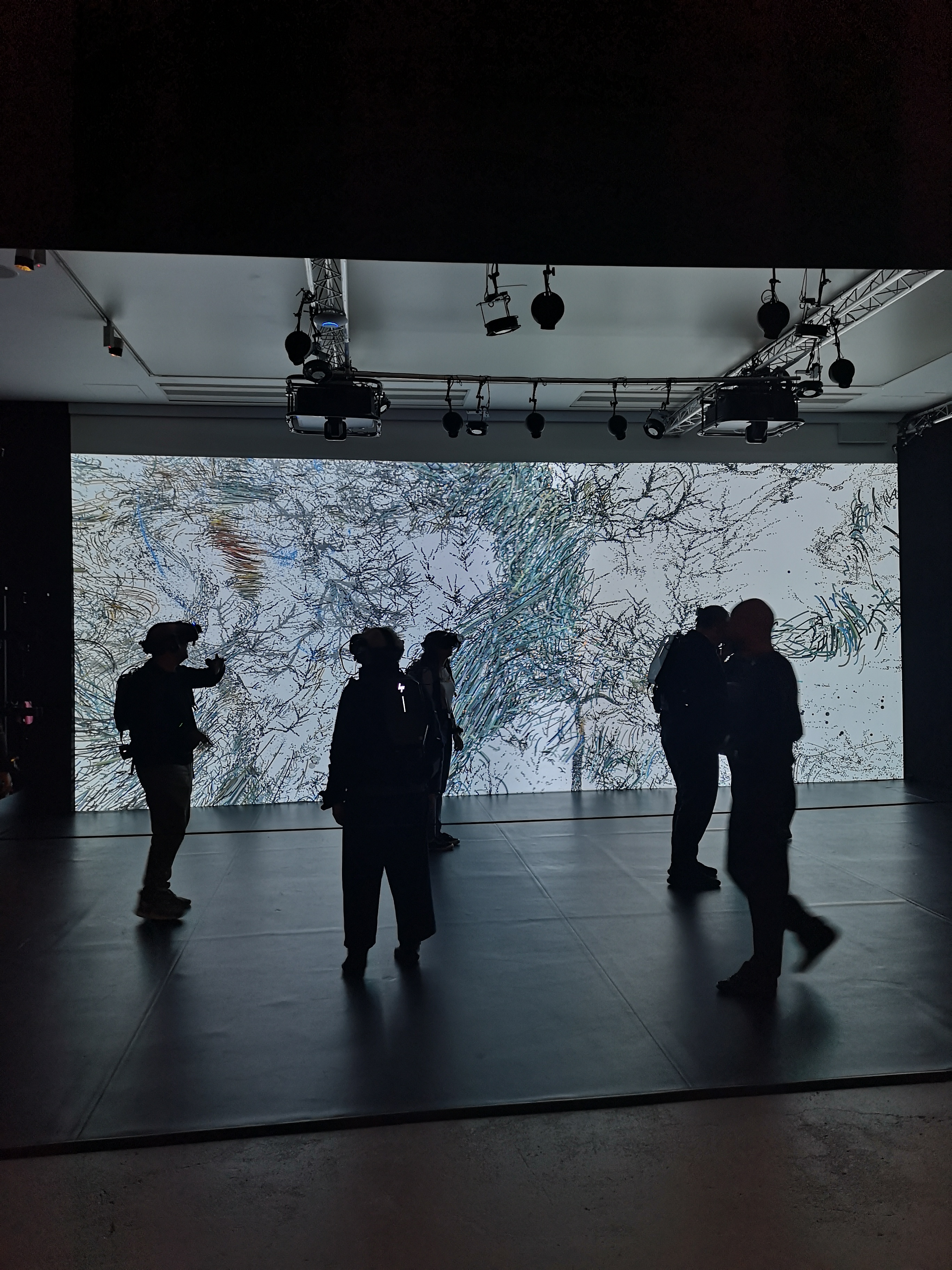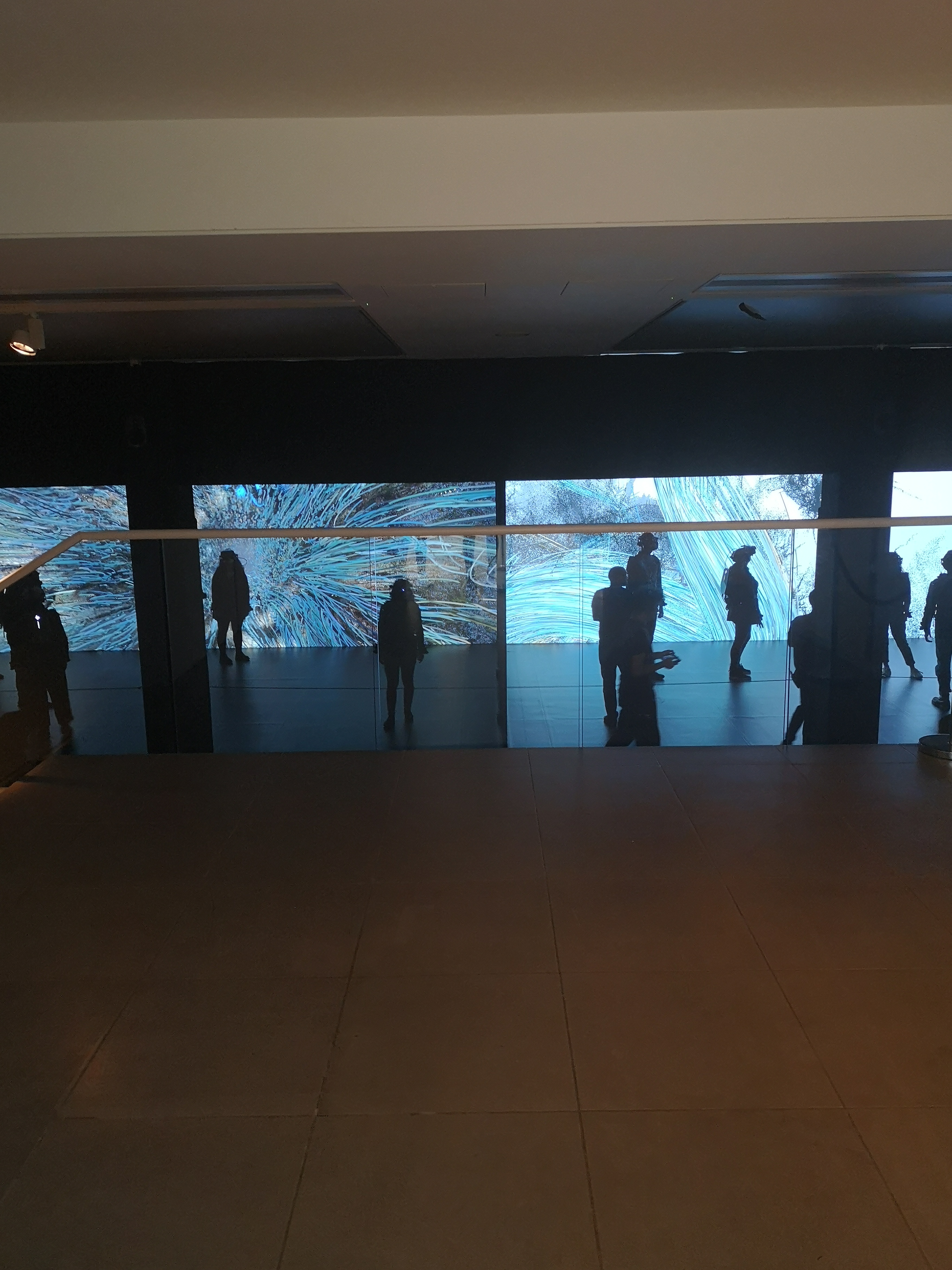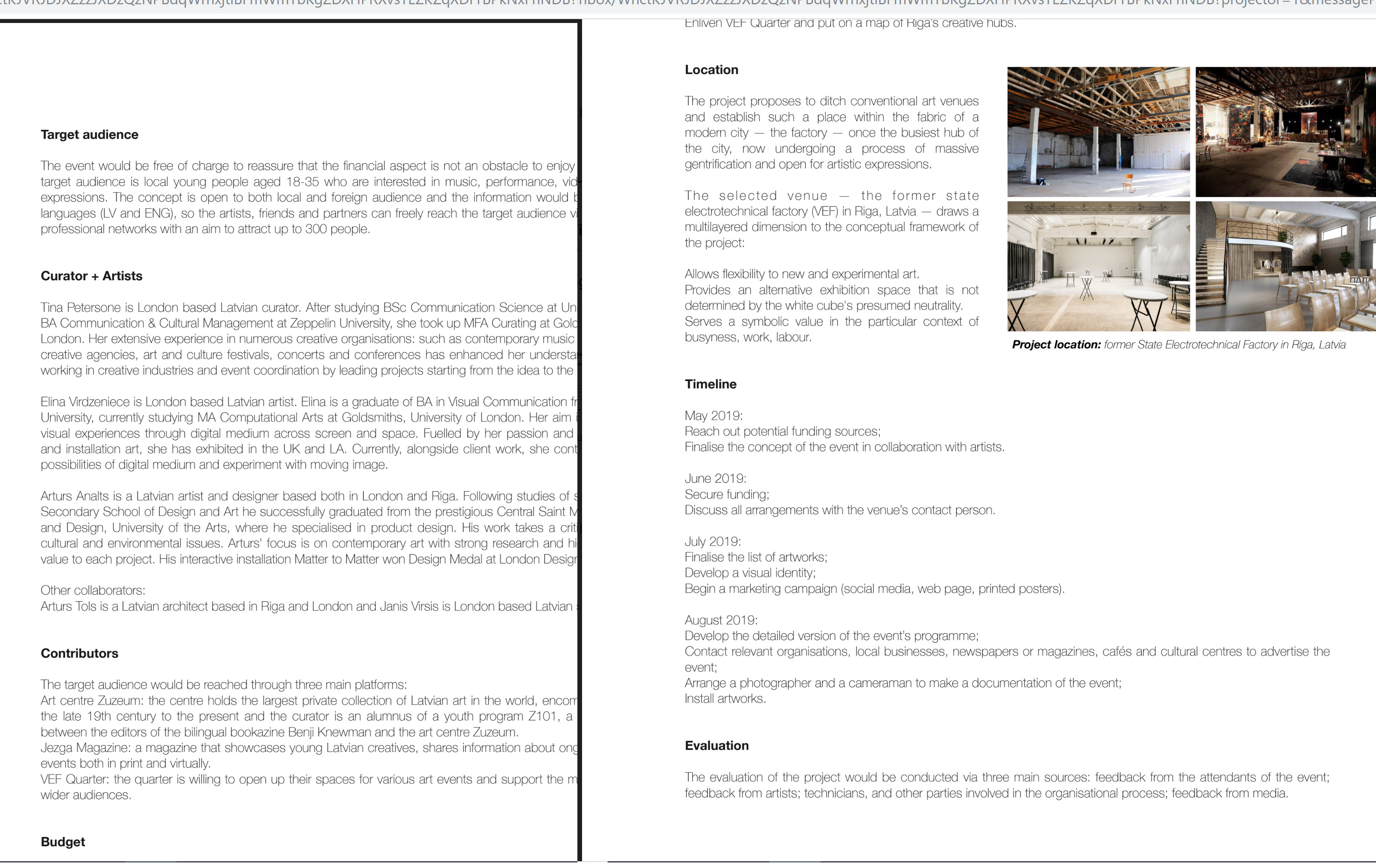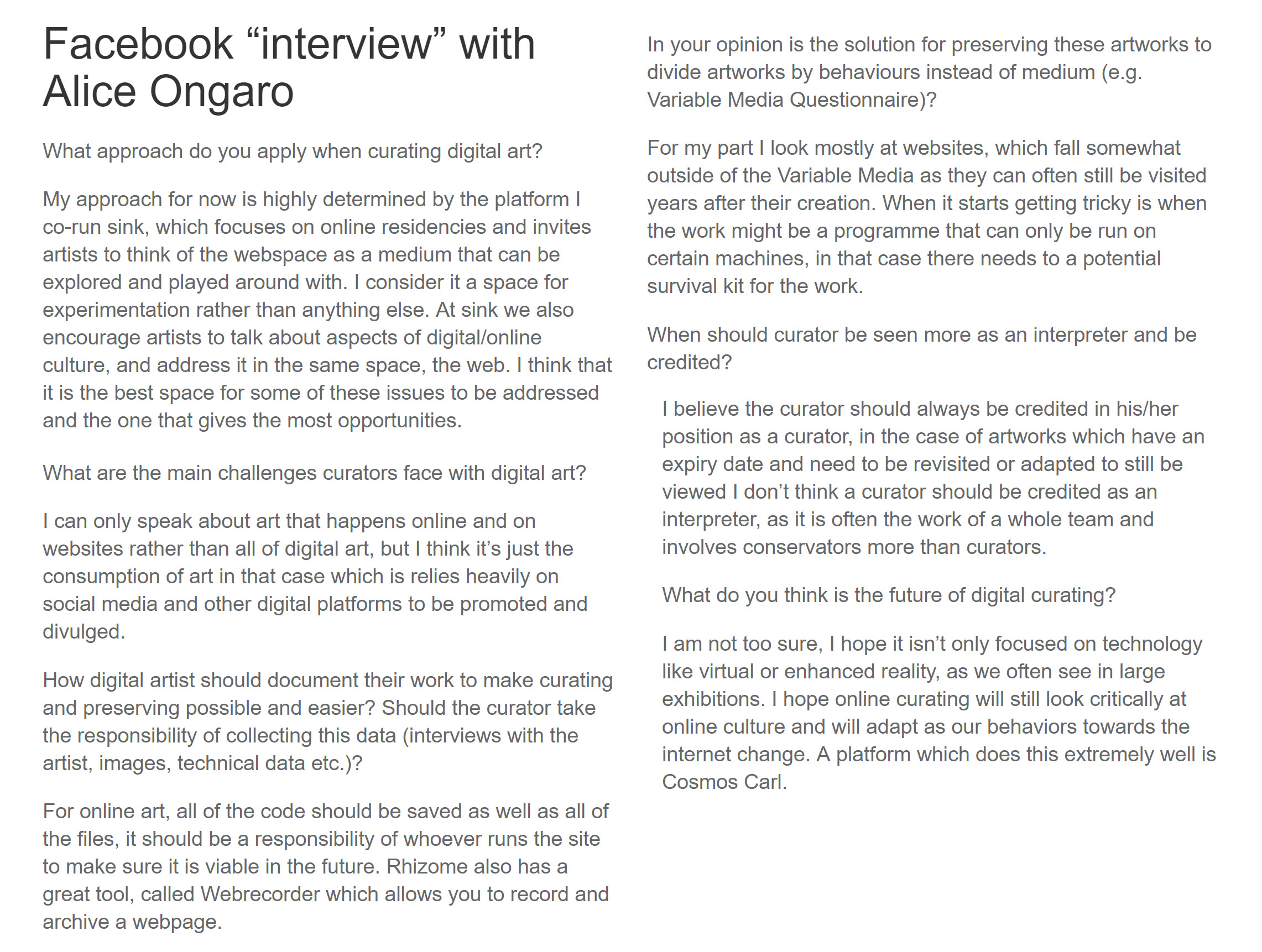Artist and Curatorial Agency // Digital Art
By Elina Virdziniece
‘Are virtual spaces and digital technologies enabling us to re-evaluate the relationship between curator and artist; between artist, curator and the process of creative practice? Or do they force challenges to the established templates of creative practice and agency?’ (Harrison and Doyle 2010).
John Gerrard. Sow Farm (near Libbey, Oklahoma) 2009.
Curating Digital/ the gap between digital artists and curators, and their current process
The central research direction for this project is the collaborative process between curator and artist when curating digital artworks, it reflects on theory and my own artistic practice. I am analysing my practice and collaborating with a curator in order to illustrate the findings of this research, which is also the artefact of this project - the collaborative process of artist and curator working together to create an exhibition. As part of this research I also looked at the critique of the approach and investigated alternative methods like artist as curator and post-human curating.
This project is supposed to add another perspective and raise attention to the collaborative practice of artists and curators working together. It also contributes to preserving digital artworks because of the importance of collecting the supporting data of each piece when practicing this curatorial approach.
Contextual Review
Let’s start with clearing up – words ‘curate’ and ‘curator’ come from the Latin curare which means to care, a word which also is related to cura (cure). Something that has been referenced before many times (Galloway Thacker, 2007 for example) and is known but had to be mentioned because of the nature of this research. Curate, care, cure, curate, care, cure, curate, care, cure. With new technologies arising curatorial models change and adapt according to the needs of the art world, but it still includes curate, care and cure.
I would like to note that in this report I refer to digital art as art which has been produced and performed using digital technologies, or like Graham (2007) defines it as art made with and for digital media. I prefer to use term digital instead of new media to also include video art. And I agree with Wade Wallerstein (2018) who defines curating digital as working with digital materials within their native material contexts or working to translate digital-native works into physical environments.
Daniel Crooks. Static No. 17 (Algorithm P), 2011.
Collaborative process
Artist and Curatorial Agency
In contrast with the past, curating no longer means only caring for objects but curators use exhibitions to express ideas through objects and processes and with this comes a lot of different roles and responsibilities the curator needs to take on. Here we will look at the most important (in my opinion) roles when applying collaborative approach.
Producer/ Commissioning// Peter Weibel (2000) like Benjamin Weil (2002) considers curator as a film producer who is more concerned with producing/ commissioning new work, and that this is the most interesting aspect of curatorial practice in new media. I argue that curators are more concerned with this, but I do think it is a very important part of the role. For Christiane Paul (2006), a curator may play a part closer to that of film producer in arranging for the public presentation of a work through overseeing a sea of creators. (Harrison 2015)
Ron Goldin understands ‘curator’ (the semantic space creator) as the initiator of a project who is, because of this, attributed a partial authorship in any resulting artefact. (Harrison 2015) By giving a set of rules in which creation must take place and at the same time describing a context for the project, the curator has embedded an idea in each resulting object. The artists, micro-authors, provide diversity in the creative process, adding another authorial stamp to the outcome. (Goldin 2002) I find very interesting Goldin’s use of words when describing artists involvement – micro-authors, I understand the idea and agree with the concept but wouldn’t describe artists as micro-authors. It feels like he is taking away agency from the artists themselves and their input.
Preservation// Weil (2002) talks about ‘data maze’ which is necessary for future exhibiting of the artwork – this is similar to the approach which Jon Ippolito suggests, also Francis T. Marchese (2011) talks about the importance of documentation but he highlights the importance of the documentation by artists themselves. Weil (2002) presents this as one of curator’s responsibilities to collect this data, where unstable data is concerned, a data maze is an inherent part of an artwork and is produced by curators who enter into a dialogue with their exhibiting artist. This collaborative process is an essential ingredient for creating good conditions for the transmission of artworks for future generations. (Harrison 2015) Harrison also talks about his practise as an example – his experience with curating Net_Working project and collecting supporting material (interviews, archived chat arena, technical data etc.), but he mentions the reason for this was to help to inform the viewer’s choice but of course the same materials could be used to help with future exhibiting of the artworks. Also, in my interview with curator Tina Petersone (2019) she mentioned countless technical error possibilities as one of the main challenges faced when curating digital art and therefore it’s crucial for the curator to understand very well how every artwork is performed. Although the reasoning behind it is not the same for every one of these artist and curators they all illustrate the importance of collecting the supporting data which is necessary for preservation.
When looking at preservation and artists agency within digital art I think one of the important parts is deciding on artworks longevity. For example, some artists choose Internet as the medium for their work because of the durational, ephemeral and ambiguous characteristics involved. They prefer not to be categorized or classified and their sites are restricted to a life span on which they decide, and which is integral to the work (Harrison 2015). At the same time artists who want their work to be preserved face the same characteristics of digital, computational and any other ‘instable’ media (defined by Benjamin Weil (2002) as technology primarily developed for other uses than art). I agree with Weil and think this leaves artists/curators with two options – either to let the artwork die and preserve nothing or to think of a model by which they can design a solution to transmit the ‘essence’ of the artwork beyond its original incarnation – for example a tool like Variable Media Questionnaire could be one of the possible solutions.
Alternative approach
Artist as Curator
“The artist as curator faces a dilemma of identity when organizing an exhibition, a struggle to become the specialist; curator as artist lacks certain credibility among artists. Without debate on authorship rights and conversely, ownership rights to the exhibition, many artists will remain outsiders to the flourishing art economy they help create. Artist is curator offers an alternative.” (Bruce Checefsky, 2015)
As part of my investigation for this research I went to Speed Curating, an event which is organised monthly by MFA curating students at Goldsmiths, University of London. The event was created with a purpose to introduce artists and curators for future collaborations. First, I found it interesting that most of the people present were artists and the second thing fascinating was that big part of the artists at the event had some curatorial experience. Which made me think that nowadays it is a very common occurrence for artists to take on curators’ role. For example, Bruce Checefsky (2015) directs and produces/ re-produces films which have not been created or which have been destroyed, he interprets the film for its future presenting as a curator by transmitting the essence of each film but also taking up the role of an artist where necessary. Also, when groups of artists and creative studios like United Visual Artists or Marshmallow Feast perform their artworks they also take the role of curators, this might be because they can control how their installations are being realized and presented. But I agree with Cook and Graham: “Although artists might be best placed to curate an emergent medium (because they work with it, they know the most about it) it is entirely possible that in a self-organized mode of working, the end result will be a project that either preaches to the converted or speaks only to an audience of peers.” (Cook and Graham, 2010) Also critique to this approach would be that artists don’t always have the skill set curators have acquired through training and practice which is necessary for a successful exhibition.
Marshmallow Laser Feast. We Live in an Ocean of Air 2018.
Collaborative Practice in Process
To accompany the findings of this research and analyse it further I am collaborating with curator Tina Petersone. She invited me to be part of her project, a group exhibition which will take place in Latvia in autumn 2019.
The entrance point in the framework of this curatorial project is the venue – VEF, state electrotechnical factory in Riga. Petersone used the historical significance of the factory as a quintessence of the project’s structure, she took every notion and used it as a separate guideline: State -> the origin of artists; Electrotechnical -> the medium artists work with; Factory -> the venue where the exhibition will take place (Petersone, 2019).
VEF in 70’s
This project brings back computing to the space where it once used to be. In its peak VEF employed 20 000 people, the factory produced communication devices, phones, light bulbs, cameras, irons, radios, flashlights, computers, cars and airplanes. Some of the items from early production have aesthetic value besides of outstanding technical qualities and can still be seen at Museum of Modern Art, New York – which seems ironic to me as one of my works which will be in the exhibition was influenced by my experience in New York - a part of VEF is in New York and part of New York will be in VEF.
VEF-MIKRO 1024 personal computer
In terms of artists taking part, Petersone wants to showcase young and emerging Latvian artists who live abroad. She wants to give a platform to exhibit our work at the place where we come from and to explore cross-cultural perspective.
The project approaches different methods of curating, one of my pieces NYC VLOG (2018) will be re-transmitted at the exhibition and I am also creating two new pieces through the collaborative process with the curator herself, the artworks, of course, will be available to be performed in other future exhibitions, but they will be specifically created for this project and heavily influenced by the location itself. One of them will be a re-interpretation of Blue Space (2018), continuous investigation of the impact between natural, artificial and digital water’s relation to our mental and physical well-being, this time with the central object being Baltic Sea. And the last piece will be a new project ‘Busyness’, installation as a metaphor to our daily busy/ noisy lives, when the environment in the space where the installation has been placed is calm and quiet you can enjoy a visual reflection of this state of calmness but if the environment becomes busy the visuals become disruptive, hectic and not enjoyable. The aim is to remind the viewer to stop the admiration and glorification of being busy.
VEF in 2018
Reflection on Collaborative Process
Comparison of the factors that influence each piece is the contrast of personal experiences, interests to curators’ idea and theme of the project, also knowing the location of the exhibition (almost site specific).
Computer simulation of NYC VLOG in the exhibition space VEF
Communication// The first meeting we had was in person, Petersone introduced me to her project and explained which of my works and why she wanted to show at the exhibition, etc. After this, she went to Latvia to explore the exhibition space, apply for funding and do the rest of the necessary things for the exhibition to happen, which is why all the communication has been online. It’s been mentioned in many net art case studies where online chat rooms serve as archives and now I have experienced how suitable online communication is for exchanging ideas and planning projects like this.
Video of parts from our first meeting
Restrictions// When working on ideas for the third piece Petersone makes me think more about ‘logistics’ like how many people will be able to participate if the piece is in VR, what would get more funding etc. Things that I wouldn’t normally have as priorities in mind when creating new work.
Elina Virdziniece. Blue Space 2.0. 2019.
Authorship// I think each of the pieces and the exhibition itself will have different ‘levels’ of mine and curator’s authorship. The first piece NYC VLOG (2018) is entirely my work and will only be re-transmitted, the second piece I would say I still have full authorship but the idea to continue this project as ‘Blue Space 2.0’ did come because of the ‘suitability’ for the curatorial project, the third piece ’Busyness’ – although my idea and work, it is very much inspired by the curators idea for the theme of the exhibition, the location, etc. also we are collaboratively deciding on which medium is more appropriate.
Elina Virdziniece. Busyness. 2019.
Conclusion and Progress
“Once you’ve curated new media art you’re unlikely to curate anything else the same way again” (CRUMB, 2008), the research project investigated the process of curating digital artworks but the process eventually can be applied to most artworks.
In conclusion, I would say curators entering the world of digital curating are open to a collaborative approach but also a lot of artists prefer to take on both of the roles. When looking closer at these processes I agree with Cook and Graham when “Concerning the wider landscape of curating as a whole, it then becomes clear that the most promising and successful solutions come from a hybrid way of working” (Cook and Graham, 2010). I think collaboration is the way to go but not only collaborative processes between artist and curator but also between curator and curator, archivist and curators, and artists, etc. Also, collaborative processes between people and machines, introducing post-human and computational curating in the collaborative approach. For example – Kurator, an open source software application designed as an online system for curating source code that can be further modified by users – ether curator, artist or archivist. (Joasia Krysa, 2007)
Finally, when looking at the experience of collaborating with curator Petersone, I think utilizing different methods for different needs and results will work best, “the only way to determine how best to curate – to produce, present, disseminate, distribute, know, explain, historicize – a work of art is to know its characteristics and its behaviours, rather than imposing a theory of art” (Cook and Graham, 2010). As far as the progress for the exhibition goes, Petersone has visited the location, etc., planned out the whole event and applied for funding for her project, and all three of my pieces are ready to be performed.
Screenshots from Tina’s application for British Council Spring Term Grant
Bibliography
Paul, Christiane. New Media in the White Cube and beyond: Curatorial Models for Digital Art. Berkeley: U of California, 2008. Print.
The book is a collection of works by many prominent practitioners in the field, edited by Christiane Paul. It outlines the structure of curating new media artworks and includes detailed analysis of four case studies of curatorial concepts behind new media exhibitions.
Jeffery, Celina. The Artist as Curator. 2015. Print.
Also, this publication is a collection of essays by many different practitioners in the field, it is edited by Celina Jeffery. Not all of the works were relevant to this project, but the others were main theory behind the investigation.
Candy, Linda, and Sam Ferguson. Interactive Experience in the Digital Age: Evaluating New Art Practice. 2014. Print. Springer Ser. on Cultural Computing.
Collection of works by creatives from different fields, edited by Linda Candy and Sam Ferguson. Looks at the ways in which digital art is impacting curating and collective disciplines, includes case studies and examples of testing the research methods.
Graham, Beryl, Sarah Cook, and Steve Dietz. Rethinking Curating: Art after New Media. Cambridge, Mass.: MIT, 2010. Print. Leonardo Books.
Jeffery, Celina. The Artist as Curator. 2015. Print.
Landwehr, Dominik, and Pour-cent Culturel Migros , Issuing Body. Machines and Robots. 2018. Print. Edition Digital Culture ; 5.
Malzacher, Florian, and Joanna Warsza. Empty Stages, Crowded Flats: Performativity as Curatorial Strategy. 2017. Print. Performing Urgency; #4.
O'Neill, Paul, Lucy Steeds, Mick Wilson, Fondation LUMA, and Bard College. Center for Curatorial Studies. How Institutions Think: Between Contemporary Art and Curatorial Discourse. 2017. Print.
Paul, Christiane. New Media in the White Cube and beyond: Curatorial Models for Digital Art. Berkeley: U of California, 2008. Print.
Thea, Carolee, Nancy Adajania, Wassan. Al-Kudhairi, David Elliott, Mami. Kataoka, Son-jong Kim, Koyo. Kouoh, Carol Yinghua. Lu, Gerardo. Mosquera, Ugochukwu-Smooth C. Nzewi, Jack. Persekian, Jose. Roca, Bisi. Silva, Alia. Swastika, How For Whom What, Carolee. Micchelli, Thomas. Christov-Bakargiev, Micchelli, Thomas, and Christov-Bakargiev, Carolyn. On Curating. 2, Paradigm Shifts: Interviews with Fourteen International Curators. 2016. Print.
Appendices
































































